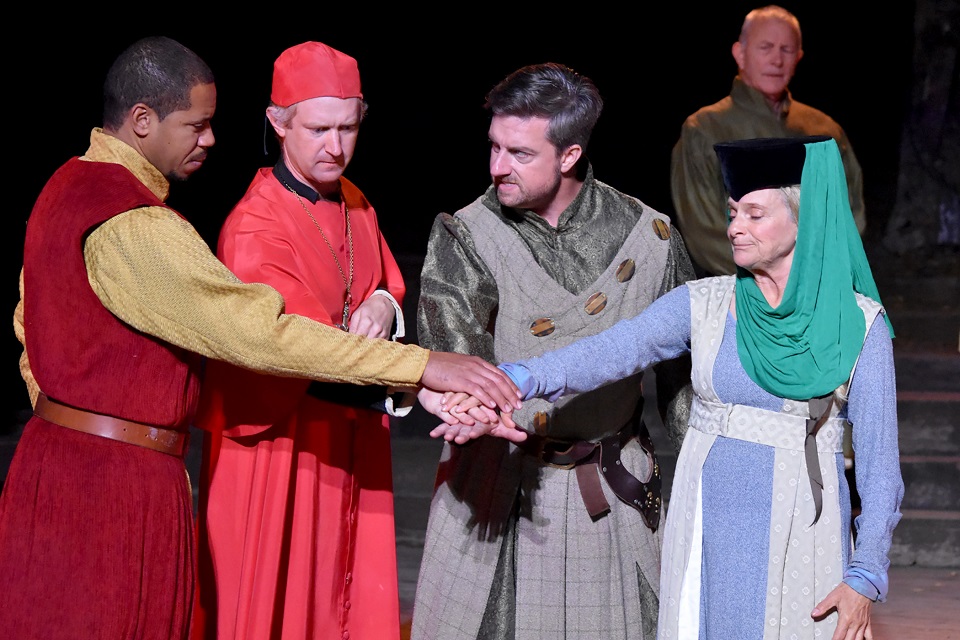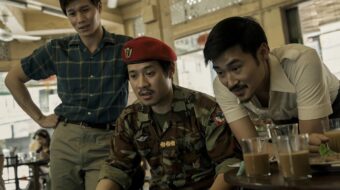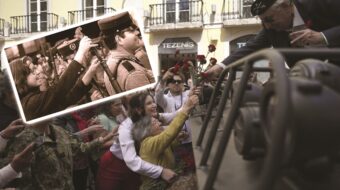
TOPANGA, Calif. — That splendid Arcadian Shakespearean reliquary, Will Geer’s Theatricum Botanicum, is presenting four of the Bard’s dramas—Parts 1, 2, and 3 of Henry VI plus Richard III—compressed, compiled and edited into a single two-act play, Queen Margaret’s Version of Shakespeare’s War of the Roses, directed by Ellen Geer. A Shakespearean scholar and playwright, Ms. Geer also stitched together this quartet of history plays by the “Prince of Poets” for WGTB, which the Shakespeare Birthplace Trust awarded a commemorative plaque with wood from Shakespeare’s Stratford-upon-Avon Garden in 2014.
Ms. Geer, who is also WGTB’s producing artistic director, has given the Richard III and Henry VI works a decidedly feminist twist, as the tale is told from the women’s point of view, just as composer André Previn and playwright Tom Stoppard re-spun Homer’s Odyssey by retelling that epic from the point of view of Ulysses’ wife, the titular Penelope. Furthermore, Queen Margaret’s Version of Shakespeare’s War of the Roses also has much to say about the depiction and treatment of individuals “afflicted” by “disability” and “deformity,” on- and offstage.
In a nutshell, the War of the Roses was a 32-year-long power struggle between branches of England’s royal House of Plantagenet that pitted the Yorks against the Lancasters, vying for the crown in civil wars from 1455-1487. WGTB’s bloody adaptation includes lots of onstage swordplay: There’s lots of hoopla about the special FX in the latest iteration of Mission Impossible, but that’s nothing compared to watching a cast of dozens dueling in the live theater, and fully utilizing and romping around the natural environs of Topanga Canyon where this amazing amphitheater is set, for an immersive experience no virtual reality could arguably rival. Queen Margaret’s other cinematic effects include stage renditions of freeze frames and slow motion action. For my florins, ducats, and doubloons, watching live actors cross swords on the boards is far more exciting than any movie magic such as CGI FX—plus, at WGTB, you don’t have to look at Tom Cruise for two hours and 43 minutes.
But for about as much time (including one intermission), you do have the opportunity to see numerous gifted, charismatic thespians depicting (in many cases) actual historic—and in some cases, histrionic—characters. The dramatis personae who appear in Shakespeare’s dramatization of the War of the Roses include the French heroine Joan of Arc (here called Joan La Pucelle, which refers to the teen’s virginity). I am rather ashamed to admit that I thought Ms. Geer was fudging by inserting that adolescent saint and freedom fighter into Queen Margaret’s, but it turns out that Jeanne d’Arc actually does indeed appear in Henry VI, Part I. Who knew? Over the decades, many notable actresses have portrayed the teenage rabble rouser who spurred France to resist the English invaders, including Maria Falconetti, Ingrid Bergman, and Jean Seberg, and now we can add to this illustrious list Claire Simba.

A French-born actress, Ms. Simba has excellent English language elocution, although as I recall her lines are delivered in, appropriately, a French accent. Simba’s La Pucelle is anything but pusillanimous; she positively spits fire as the fanatical “warrior of God” who was burned at the stake for being a “witch” at Rouen in 1431. (Although this was before the War of the Roses commenced, the cross-Channel conflicts between England and France helped set the stage for London’s subsequent civil wars.) Ms. Simba, whose credits include the Madame Secretary TV series, has multiple roles in Queen Margaret’s, wherein she also plays Lady Anne in some pretty fancy-schmancy Middle Ages headgear. This young actress is a talent we should keep our eyes on.
Other standouts in this large cast are veterans of the WGTB troupe, including Melora Marshall, who portrays the titular Queen Margaret. Her bravura depiction spans the decades—just as the actual War of the Roses did—from a young blonde maiden marrying a monarch to a white-haired wraith railing against the iniquities of the endless faction fights to gain the crown. Willow Geer, who also has an assistant director credit, passionately plays Duchess Eleanor and later Lady Elizabeth Grey, who get enmeshed in the murderous mayhem. (Note: Ticket buyers might want to get sitters and leave the kiddies at home, as this bloody production, which includes onstage severed heads upon pikes—you see, some actors really do give it their all, talk about Method Acting!—and the offstage murder of children, may not be suitable for tykes.) Other WGTB stalwarts who tread the Bard’s boards are the swashbuckling Max Lawrence as the Duke of York and Gerald Rivers, as Buckingham.
To me, this epic’s best portrait was painted by Jon Sprik as Richard III, the supposedly misbegotten monarch (Sprik also plays Suffolk). It is a portrayal of “deformity” and “disability”—and of sheer depravity. Since birth, Richard has been endlessly calumnied and insulted as a “crookback” who is “misshapen,” and Sprik, who according to WGTB’s publicist is offstage what we call “able-bodied,” artfully incarnates the physical imperfections Shakespeare has endowed his character with. These perceived corporeal blemishes have bequeathed a deeply flawed psyche on the man who would be king at all and any costs, including the homicides of his brothers, regal marriages of convenience under false pretenses, and more.
Sprik perfectly captures the damaged spirit of a character whom the world made suffer because of his physical differences and is therefore hellbent on vengeance, determined to make the world pay for it. When he murders his brother the king, Richard is not content to merely quip that he is sending his sibling to hell, but adds that the deposed monarch should tell Satan he sent him there. Which reminds me that the dialogue is richly marinated with the Bard’s immortal prose and poetry. Consider the fact that the 1968 WWII movie Where Eagles Dare starring Clint Eastwood and Richard Burton undoubtedly derived its name from this quote made by Richard III’s title character in Act I, Scene III: “The world is grown so bad, that wrens make prey, Where eagles dare not perch.” William Shakespeare’s influence is everywhere in the English-speaking world, and we are fortunate that outposts such as Will Geer’s Theatricum Botanicum perpetuate this rich literary legacy.

Having said that, the 2022 British feature The Lost King, directed by Stephen Frears and starring Sally Hawkins and Steve Coogan, strongly disputes Shakespeare’s dramatization of the life of King Richard III and its accuracy, ranging from his “deformed” body to his allegedly killing his brothers to his being a “usurper” and so on. Be that as it may, this should not distract us from the enjoyment and appreciation of Queen Margaret’s Version of Shakespeare’s War of the Roses, which channels Shakespeare’s interpretation. The keen 21st-century eye might also perceive contemporary references to America today, being threatened by Trumpian pretenders to the throne and the MAGA minions storming the palace of democracy. From the 15th century up to now, the course of human events remains the greatest show on Earth, awaiting the dramatist’s twists and turns to paint it and put it into perspective.
Will Geer’s Theatricum Botanicum is presenting Queen Margaret’s Version of Shakespeare’s War of the Roses through October 1 in repertory with Macbeth, A Midsummer Night’s Dream, and A Perfect Ganesh at 1419 North Topanga Canyon Blvd., Topanga, California 90290. For info and tickets, call (310) 455-3723 or go to the company website.
We hope you appreciated this article. At People’s World, we believe news and information should be free and accessible to all, but we need your help. Our journalism is free of corporate influence and paywalls because we are totally reader-supported. Only you, our readers and supporters, make this possible. If you enjoy reading People’s World and the stories we bring you, please support our work by donating or becoming a monthly sustainer today. Thank you!












Comments